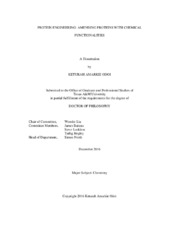| dc.description.abstract | Directly incorporating noncanonical amino acids (NCAAs) into proteins in living cells is an indispensible technique for investigating structures and functions of proteins. This co-translational insertion of NCAAs, which is similar to post-translational modifications (PTM), amends proteins with new functionalities. With the idea of synthesizing proteins with defined modifications to generate proteins with enhanced properties, the first goal was to assess the capacity of codon recognition of the original or derivative Methanosarcina mazei pyrrolysyl (Pyl)-tRNA synthetase (PylRS)-tRNA^Pyl pair, and also expand the current NCAA-coding codons to sense or quadruplet codons. These systematic studies expounded on the cross recognition between nonsense or sense codons with various tRNA^Pyl anticodons in E. coli.
One interesting result that was obtained showed that E. coli itself displays a relatively high opal suppression level; tryptophan (Trp) is incorporated at an opal mutation site. Although the PylRS- tRNA^Pyl UCA pair can be used to encode N^ε-tert-butoxycarbonyl-l-lysine (BocK) at an opal codon, the pair fails to suppress the incorporation of Trp at the same site. For the sense and quadruplet codons, their tRNA did not fully deliver BocK at the AGG and AGGA codon sites when co-expressed with PylRS in E. coli, hence contamination by natural amino acids were spotted.
Based on the above studies carried out, the next goal was to use the highly orthogonal pair, mutant PylRS-tRNA^Pyl CUA, to genetically encode five tyrosine derivatives. These derivatives contain either a norbornene, trans-cyclooctene, or cyclooctyne entity encoded into proteins for site specific protein labeling. These NCAAs were successfully labeled with a fluorescein tetrazine dye and a diaryl nitrilimine both in vitro and in living cells. Detailed kinetic analyses of inverse electron-demand Diels–Alder cycloaddition and nitrilimine-alkene/alkyne 1,3-diploar cycloaddition reactions were conducted and the reactions were applied for rapid protein bioconjugation. When reacted with a tetrazine or a diaryl nitrilimine, strained alkene/alkyne entities including norbornene, trans-cyclooctene, and cyclooctyne displayed rapid kinetics.
Lastly, the study of histone PTM is a crucial step in chromatin states and epigenetic regulations of gene expressions in all eukaryotes because of its complex network of possible PTM combinations, which to this day, is being deciphered. Here, the goal of the research is to profile different lysine sites on histones by mapping out the effects of epigenetic erasers such as HKDMs on the sites. Results showed catalytic activity of LSD1 on various lysine sites on H2A, H2B and H3 histone substrates using a peroxidase-coupled assay of the catalytic activity of LSD1. | en |


